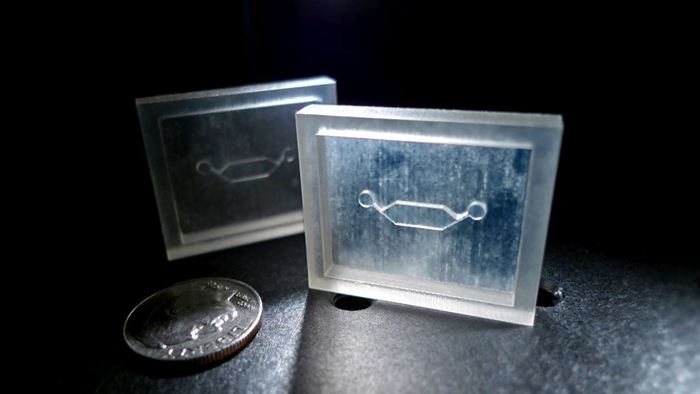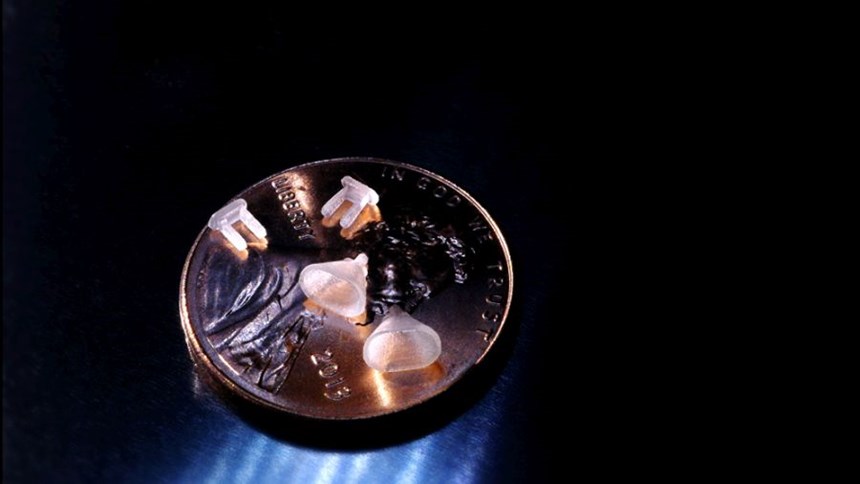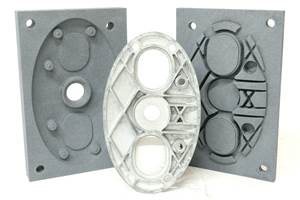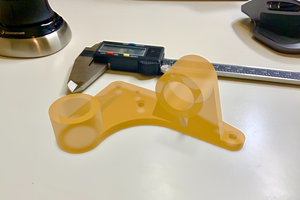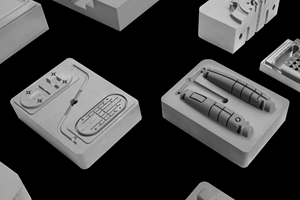Where 3D Printing Makes Sense for Micro Medical Devices
A contract manufacturer uses stereolithography to produce high-quality medical devices on a micro-scale for prototyping and end use.
Share
Read Next
Potomac Photonics, a contract manufacturer located in Baltimore, Maryland, is familiar with the common challenges of 3D printing, like build orientation, resolution and surface finish. But in Potomac’s case, these challenges are magnified—literally. The company is known for its microfabrication work, and has the ability to machine, laser cut and 3D print parts on a very small scale. Micromachining expertise combined with a dual-material SLA 3D printer enables the company to create a number of medical devices and device components, both in prototype and for end use.
Founded in 1982, Potomac Photonics is located at “Bwtech@UMBC” Research and Technology Park, the university research park for the University of Maryland, Baltimore County. The company has conducted collaborative projects with commercial and government agencies in medical device manufacturing, biotech and electronics fabrication. Using technologies ranging from laser micromachining to hot embossing, the company can micromachine materials including polymers, metals, ceramics and glass. The parts the company produces frequently demand features down to 1 micron, and in some cases even smaller, says Mike Adelstein, president and CEO.
For its additive manufacturing work, Potomac relies on a 3D Systems Projet 3500 3D printer capable of layer thickness down to 16 microns (smaller features are achieved by micromachining printed parts. The SLA printer uses a two-material process that can print wax supports and voids alongside the polymer for the part. Once the build is complete, support removal is fast and easy. The wax is melted away in an oven, leaving behind a surface finish that is good enough for functional prototyping and even some end-use applications. Two example applications for the medical industry are pictured in the slideshow above.
The first photo (Figure 1) shows a pair of components developed with Memorial Sloan Kettering Cancer Center that compose a microfluidic mold. The mold in turn is used to make a polydimethylsiloxane (PDMS) microchamber for growing cancer cells in a controlled environment. These microchambers are commonly used in biology and biomedical applications, but developing and producing them using traditional moldmaking can create a costly bottleneck. By 3D printing these acrylic prototypes, Potomac was able to save cost and reduce lead time for the cancer center.
Figure 2 shows a set of components for an ear implant used to treat otosclerosis disease. Otosclerosis is an abnormal hardening of the stapes bone inside the middle ear. Commonly called the stirrup bone, the stapes is responsible for moving the inner ear fluids to enable the sensory process of hearing. If the bone becomes fixed, its ability to generate these vibrations is limited, resulting in hearing loss.
The parts pictured were created for a stapes prosthesis developed by the Institute of Micromechanics and Photonics at Warsaw Technical University in Poland. Though these are prototypes, they were used to verify that the device geometry would allow it to be implanted into a temporal bone. Prior to turning to Potomac, the institute had tried another 3D printing process that did not achieve the small, precise geometries and tight tolerance necessary for this verification. Given the quality that Potomac has been able to achieve in these small prototypes, it may be economically viable to 3D print short production runs of this prosthetic.
In both cases, the parts are shown following the removal of the wax, but without any additional postprocessing. Achieving these results is part equipment, part trial and error, and part know-how. The resolution of the printer contributes, but factors such as laser power and orientation also play a role. The shop has learned through experience what the best orientation for a given part is likely to be, but also performs testing when needed. The Projet's 11.75 × 7.3-inch (298 × 185-mm) build platform enables Potomac to print the same component in multiple orientations in a single build, so as to quickly determine the optimal orientation.
Even with past experience and up-front work, though, “Sometimes we reach the limits of what 3D printing can do,” says Adelstein. In these cases, the shop turns to a combination of its micromachining technologies. It might 3D print the part as near-net-shape as possible, then use the laser to machine the smallest features, for example. Or the company might switch from 3D printing small batches of a part to machining or molding it if production takes off. “It could be good for one stage of the project, but it’s not always good for the whole project,” he says.
In all cases, Potomac seeks to choose the technology that will best serve the needs of its customers. The 3D printer is used where it can save time and cost while meeting required tolerances. As the technology develops and new materials are introduced, Adelstein sees its usage for production growing.
Related Content
Foundry Lab: How Casting in a Day Will Improve the Design of Metal Parts (Includes Video)
The company’s digital casting process uses 3D printing, but the result is a cast part. By providing a casting faster than a foundry, the company says effective prototyping is now possible for cast parts, as well as bridge production.
Read More4 Ways Augmented Reality and 3D Printing Intersect
Augmented reality (AR) is bringing benefits to additive manufacturing, and vice-versa.
Read MoreTitanium Golf Club Line Leverages AM to Boost Clubhead Performance
Japanese lifestyle golf brand Designer utilizes Farsoon 3D printing to optimize the design and production of its latest titanium golf club line.
Read MoreComplete Speaker Lineup Announced for the 3D Printing Workshop at NPE2024: The Plastics Show
Presentations will cover 3D printing for mold tooling, material innovation, product development, bridge production and full-scale, high-volume additive manufacturing.
Read MoreRead Next
Bike Manufacturer Uses Additive Manufacturing to Create Lighter, More Complex, Customized Parts
Titanium bike frame manufacturer Hanglun Technology mixes precision casting with 3D printing to create bikes that offer increased speed and reduced turbulence during long-distance rides, offering a smoother, faster and more efficient cycling experience.
Read MoreAlquist 3D Looks Toward a Carbon-Sequestering Future with 3D Printed Infrastructure
The Colorado startup aims to reduce the carbon footprint of new buildings, homes and city infrastructure with robotic 3D printing and a specialized geopolymer material.
Read MoreProfilometry-Based Indentation Plastometry (PIP) as an Alternative to Standard Tensile Testing
UK-based Plastometrex offers a benchtop testing device utilizing PIP to quickly and easily analyze the yield strength, tensile strength and uniform elongation of samples and even printed parts. The solution is particularly useful for additive manufacturing.
Read More
.jpg;width=70;height=70;mode=crop)
